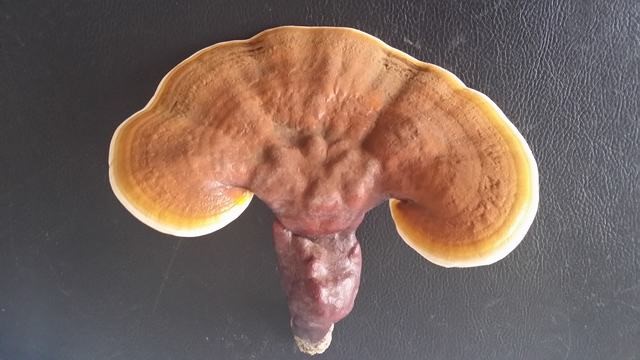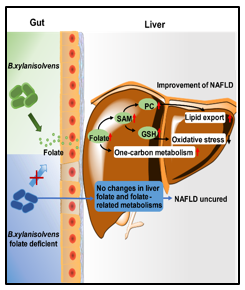Professors LIU Hongwei’s group and LIU Shuangjiang’s group at Institute of Microbiology, Chinese Academy of Sciences, reported the anti-NAFLD effects of a Ganoderma meroterpene derivative that increased the abundance of Bacteroides spp. to activate Bacteroides-folate-liver pathway and further alleviate Nonalcoholic fatty liver disease (NAFLD). The article entitled “Activation of a Specific Gut Bacteroides-Folate-Liver Axis Benefits for the Alleviation of Nonalcoholic Hepatic Steatosis” was published on Cell Reports on August 11, 2020.
NAFLD, one of the most common chromic liver diseases, has become a worldwide health concern. However, no effective drugs have been approved so far. The outstanding chemical diversity and bioactivity of natural products and their derivatives have put them under the spotlight as potential sources of drugs. Ganoderma mushroom, for example, have been used as a traditional Chinese herbal medicine for thousands of years.
Recently, a study demonstrated the effect of a Ganoderma meroterpene deriviative (GMD) in ameliorating nonalcoholic hepatic steatosis in fa/fa rats. According to the study, the administration of GMD increased lipid oxidation, suppressed de novo lipogenesis, and lipid export from the liver, and inhibited endotoxema. Yet, as an active agent less likely to be absorbed through oral administration, the mechanism of GMD’s effect is elusive.


Figure title: The mechanism of GMD to attenuate NAFLD by targeting Bacteroides-folate-liver axis. (A) the picture of Ganoderma lucidum; (B) the graphical abstract of this article, image by Prof. LIU Hongwei and LIU Shuangjiang’s groups.
After in vitro and in vivo assays, researchers confirmed that an altered gut microbiota with an increase of butyrate and folate-producing gut bacteria were the key factors that contributed to the therapeutic effects of GMD on NAFLD. Four folate-producing bacteria, Bacteroides xylanisolvens, B. thetaiotaomicron, B. dorei, and B. uniformis, enriched by GMD were identified. This is the first report about the ability for these four intestinal bacteria to produce folate.
Furthermore, oral administration of live B. xylanisolvens, which is the bacterium most boosted by GMD, alleviated hepatic steatosis in mice with the activation of folate-mediated signaling pathways. To validate the role of gut-produced folate in NAFLD, researchers generated a folate-deficient strain of B. xylanisolvens (BXΔfolP) by knocking out the folp gene in the folate biosynthetic pathway. Gavages with BXΔfolP failed to alleviate NAFLD in mice.
In summary, LIU Hongwei’s group demonstrates the anti-NAFLD effect of a Ganoderma-derived compound, identifies a specific and useful gut Bacteroides-Folate-Liver Axis for the treatment of NAFLD, and discovers a group of potential probiotics beneficial for the prevention of NAFLD. This important finding opens up a new perspective for future NAFLD drug discovery and broadens the scope of NAFLD treatments.
QIAO Shanshan, BAO Li and WANG Kai from IMCAS are the first authors of this paper.
The study was supported by the National Key R&D program of China (2019YFA0905602), the National Natural Science Foundation of China (81773614), the Strategic Priority Research Program of Chinese Academy of Sciences (Grant No. XDB 38020300), and the Key Research Program of the Chinese Academy of Sciences (Grant KFZD-SW-219).
DOI:https://doi.org/10.1016/j.celrep.2020.108005
Contact:
Prof. LIU Hongwei
State Key Laboratory of Mycology (SKLM), Institute of Microbiology, Chinese Academy of Sciences,100101,Beijing, China
E-mail: liuhw@im.ac.cn